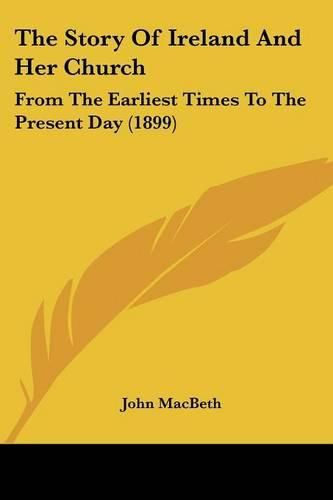Readings Newsletter
Become a Readings Member to make your shopping experience even easier.
Sign in or sign up for free!
You’re not far away from qualifying for FREE standard shipping within Australia
You’ve qualified for FREE standard shipping within Australia
The cart is loading…






Purchase of this book includes free trial access to www.million-books.com where you can read more than a million books for free. This is an OCR edition with typos. Excerpt from book: CHAPTER II. HISTORICAL EPOCHS. IT is only necessary to draw attention to a few of the more eminent pagan monarchs of the Milesian race, and note one or two epochs in the history of the country which in some degree are connected with the introduction of Christianity. Almost contemporaneously with the founding of the Milesian monarchy, the Picts settled in North Britain. The reign of Ollamh Fodhla is considered one of the chief epochs in Irish annals. He is said to have instituted at Tara?which at a later age became the capital of Ireland?a triennial convention of princes, Druids, and chiefs, at which laws were made, and the national records kept by the bards were corrected and registered. The book in which they were said to be registered was known in later times as The Psalter of Tara, to which Bishop Cormac’s Psalter of Cashel was indebted for much of its contents. Laws were also made by which trades and professions became hereditary in families, and special coats of arms were granted to the most distinguished chiefs as a reward of merit and an incentive to valour. The only device hitherto borne on the Milesian banner was a dead serpent, and the rod of Moses, which their Gadelian ancestors had adopted in Egypt. Queen Macha of the Golden Hair and her husband Kimbay, King of Ulster, built the famous rath and palace of Emania, about 300 years before the Christian era. They were situated about a mile and a half from Armagh,1 and their erection is considered by some writers as the earliest authentic event in our national history. The large mound and enclosures cover about eleven acres. It is now called Navan 2 Fort, a name in which is still preserved its original designation. This ancient palace?which was destroyed about the middle of the fourth century?was the chief res…
$9.00 standard shipping within Australia
FREE standard shipping within Australia for orders over $100.00
Express & International shipping calculated at checkout
Stock availability can be subject to change without notice. We recommend calling the shop or contacting our online team to check availability of low stock items. Please see our Shopping Online page for more details.
Purchase of this book includes free trial access to www.million-books.com where you can read more than a million books for free. This is an OCR edition with typos. Excerpt from book: CHAPTER II. HISTORICAL EPOCHS. IT is only necessary to draw attention to a few of the more eminent pagan monarchs of the Milesian race, and note one or two epochs in the history of the country which in some degree are connected with the introduction of Christianity. Almost contemporaneously with the founding of the Milesian monarchy, the Picts settled in North Britain. The reign of Ollamh Fodhla is considered one of the chief epochs in Irish annals. He is said to have instituted at Tara?which at a later age became the capital of Ireland?a triennial convention of princes, Druids, and chiefs, at which laws were made, and the national records kept by the bards were corrected and registered. The book in which they were said to be registered was known in later times as The Psalter of Tara, to which Bishop Cormac’s Psalter of Cashel was indebted for much of its contents. Laws were also made by which trades and professions became hereditary in families, and special coats of arms were granted to the most distinguished chiefs as a reward of merit and an incentive to valour. The only device hitherto borne on the Milesian banner was a dead serpent, and the rod of Moses, which their Gadelian ancestors had adopted in Egypt. Queen Macha of the Golden Hair and her husband Kimbay, King of Ulster, built the famous rath and palace of Emania, about 300 years before the Christian era. They were situated about a mile and a half from Armagh,1 and their erection is considered by some writers as the earliest authentic event in our national history. The large mound and enclosures cover about eleven acres. It is now called Navan 2 Fort, a name in which is still preserved its original designation. This ancient palace?which was destroyed about the middle of the fourth century?was the chief res…